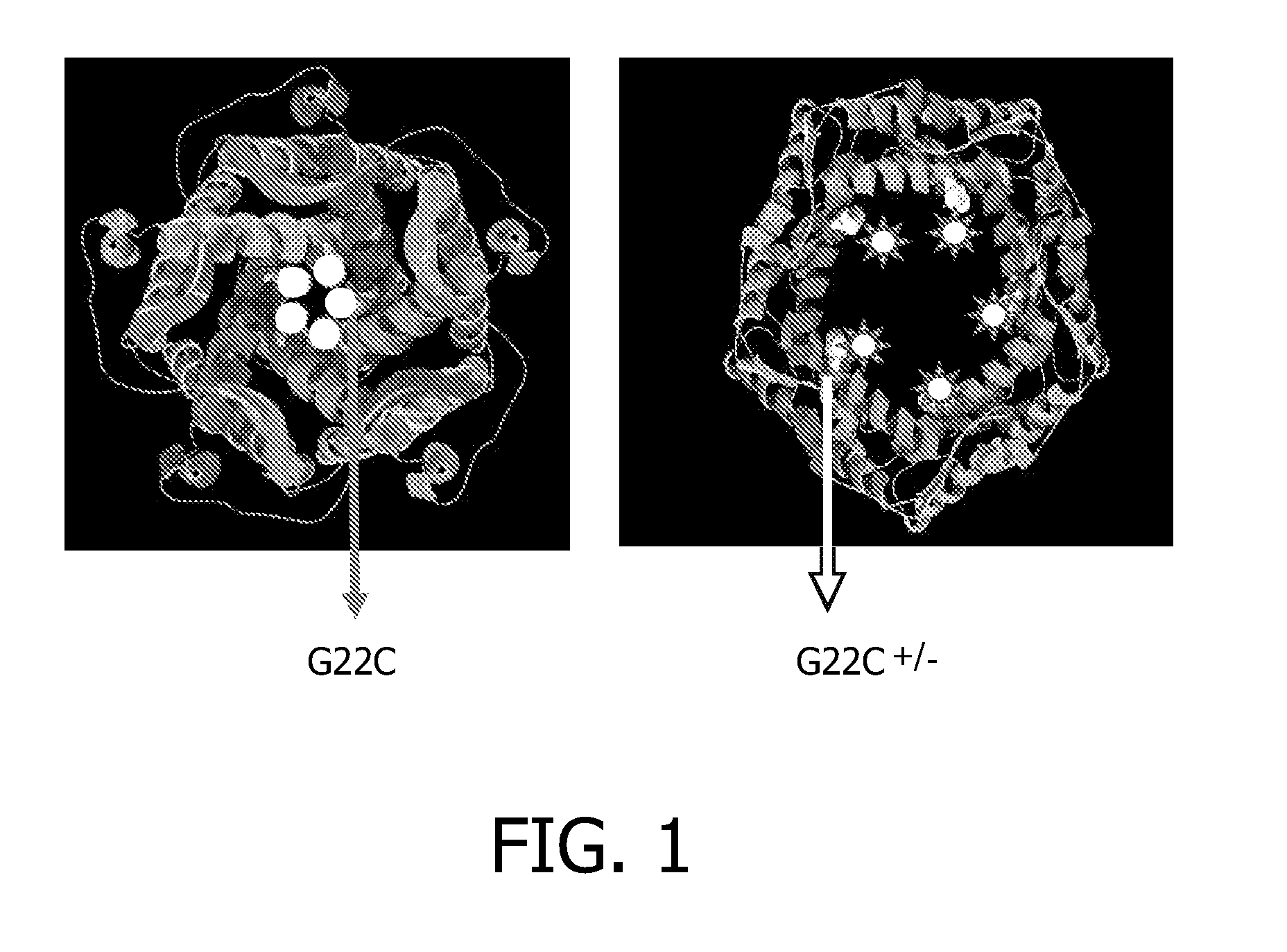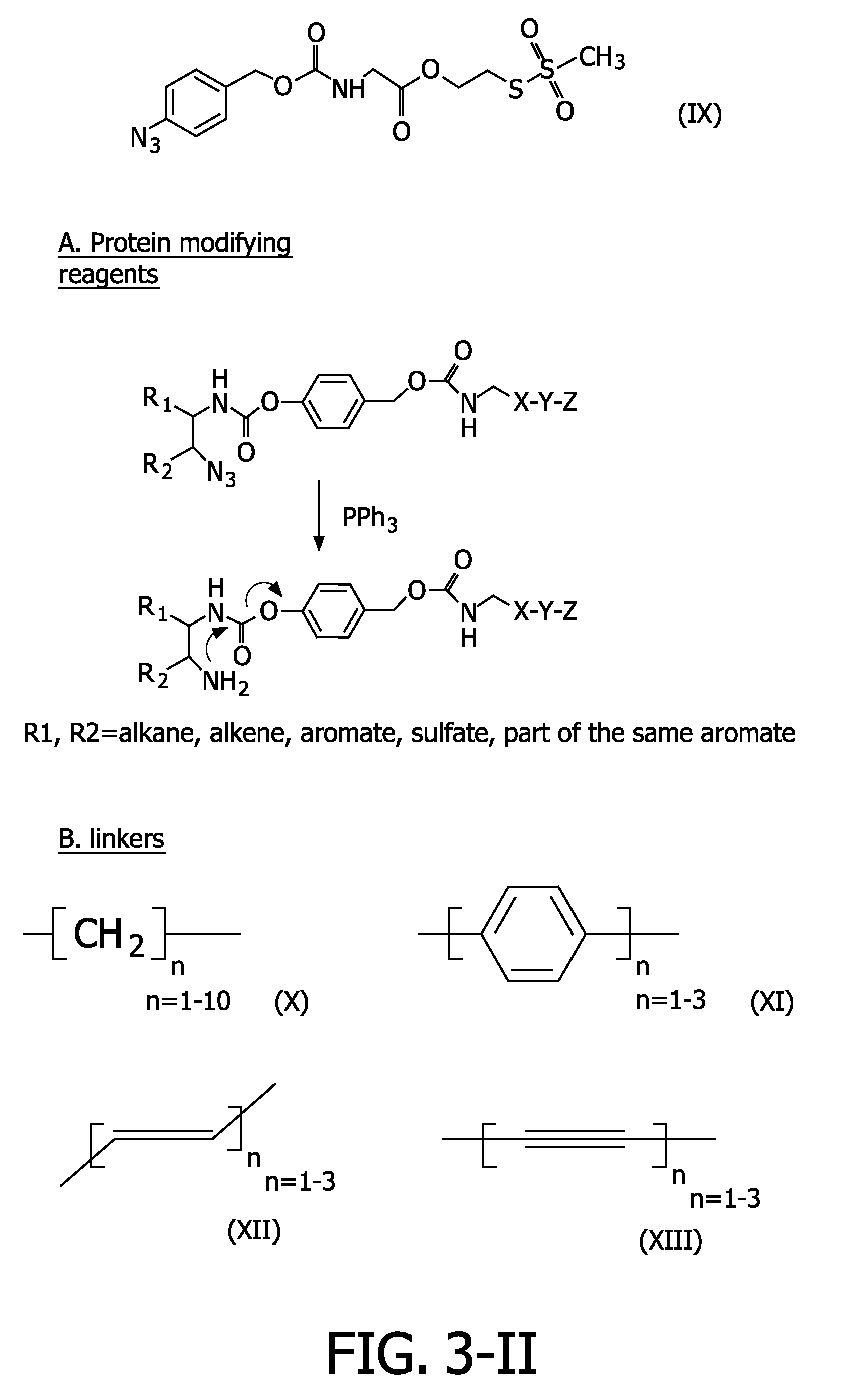Azide modified charge sensitive channel proteins
a charge sensitive channel and azide technology, applied in the field of protein modification, can solve the problems of hydration of pores, indirect, unpredictable and non-universal control over the subsequent release of these liposomes, and the inability to deliver a large number of drug compounds safely and/or effectively by conventional routes or dosage forms, etc., to achieve superior control over the release profile of drug compounds, improve the therapeutic window, and modify the structural/functional properties
- Summary
- Abstract
- Description
- Claims
- Application Information
AI Technical Summary
Benefits of technology
Problems solved by technology
Method used
Image
Examples
example 1
Preparation of the Thiol Reactive Reagent of Formula (VIII)
[0152]Compound 13 was prepared following a published procedure disclosed in Banaszynski et al. (2005) J. Am. Chem. Soc. 127(13), 4715-4721.
[0153]Compound 14 was prepared by adding bromoethanol (7.3 mL, 102 mmol) to azide 13 (1.03 gram, 10.2 mmol). The pink solution was cooled to 0° C. and thionylchloride (0.94 ml, 13 mmol) was added dropwise over a period of 10 minutes, keeping the reaction mixture below 10° C. The reaction mixture was stirred at RT for 1 h and subsequently toluene (150 ml) was added and the solution was evaporated. To the resulting light brown liquid dichloromethane (100 ml) was added and the solution was washed with water (3×100 ml), brine, dried over MgSO4, filtered and evaporated. Column chromatography (silica gel, dichloromethane) afforded 14 as a colourless liquid (1.60 gram, 7.7 mmol, 75%). 1H NMR (300 MHz, CDCl3) δ 4.52 (t, 2H, J=6.0 Hz), 3.95 (s, 2H), 3.55 (t, 2H, J=6.0 Hz). 13C NMR (75 MHz, CDCl3) ...
example 2
Labelling of MscL with a Thiol Reactive Azide
[0156]The E. coli channel protein MscL Gly22Cys was labelled with azide 7 (abbreviated as MA) during its isolation. Details on the recombinant expression of MscL are described in detail in WO2005051902. Recombinant His-tagged MscL was overexpressed in a bacterial host. The membrane of the host containing recombinant MscL was solubilized in detergent containing buffer and it is applied to a Ni-NTA affinity column. MA (7) dissolved in DMSO is added to the bound protein (theoretical final concentration 100 mM) and incubated for 30 min at RT. Since the channel is a homopentamer, the modification builds in 5 azide moieties, which face each other in the hydrophobic pore of the MscL channel. Unreacted MA is washed from the column and the azide labelled His-tagged protein is eluted with a Histidine gradient. MscL protein modified with the thiol reactive azide (7) is abbreviated as MsCl-MA.
example 3
Reconstitution of MscL-MA into Liposomes Containing Calcein
[0157]MscL-MA was reconstituted into synthetic liposomes composed of azolectin by using a detergent mediated reconstitution method. The incorporation of channels protein in lipid vesicles is describe in detail in WO2005051902 This procedure was performed in the presence of calcein, a self-quenching fluorescent dye. At high local concentrations inside the liposomes, the fluorescence of calcein is low. Release of calcein from liposomes results in dilution of the dye and consequently in a large increase in fluorescence intensity. The labelling and reconstitution was validated by using unlabeled MscL instead of MscL-MA.
PUM
| Property | Measurement | Unit |
|---|---|---|
| diameter | aaaaa | aaaaa |
| pH | aaaaa | aaaaa |
| diameter | aaaaa | aaaaa |
Abstract
Description
Claims
Application Information
 Login to View More
Login to View More - R&D
- Intellectual Property
- Life Sciences
- Materials
- Tech Scout
- Unparalleled Data Quality
- Higher Quality Content
- 60% Fewer Hallucinations
Browse by: Latest US Patents, China's latest patents, Technical Efficacy Thesaurus, Application Domain, Technology Topic, Popular Technical Reports.
© 2025 PatSnap. All rights reserved.Legal|Privacy policy|Modern Slavery Act Transparency Statement|Sitemap|About US| Contact US: help@patsnap.com



